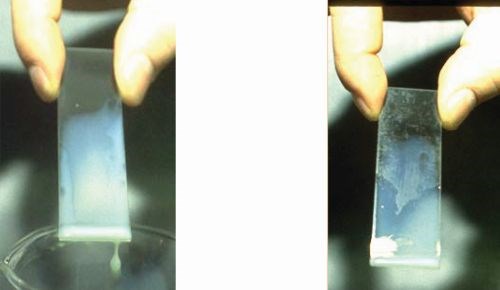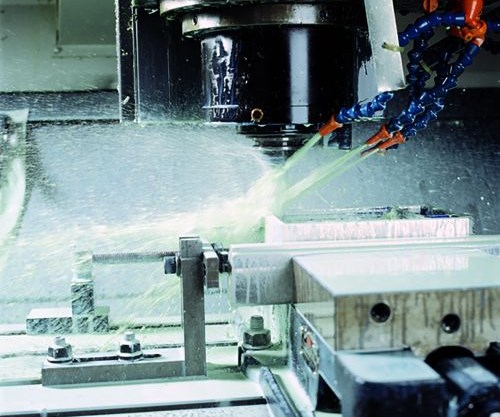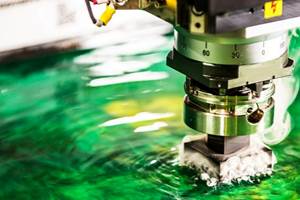A Guide to Metalworking Fluids
The oils, coolants and lubricants used in metalworking shops are often overlooked as an opportunity to improve process efficiencies.
When the shop floor sends out a call for a process engineer to come out and check on an issue, it is usually to find a solution to something in the process operation that is not providing the production results expected. These might include tolerances, cycle times and surface finishes, to name a few.
All aspects of a metalworking operation should be considered because a process is a system; 99 percent of the time the programmed procedure becomes the focus, as it should, to start. However, when all the excess time is wrung out of the program and still the process is too long or the tooling isn’t lasting long enough, it’s on to a next step.
The tooling expert is called in or the process engineer goes out to the tooling websites to explore all the options. Obtaining a special drill or new insert is normal and is easy to implement. A few more seconds get shaved off, but still not enough.
Then, he starts looking at the way the part is manufactured (fixtures, mounting surfaces), attempting to do more in each operation and trying to reduce cycle time. He obtains all the savings he can with the present technology at his disposal—or maybe not.
When working with tube and material drawing shops, the lubricant governs the entire operation. Combine speed, (activating the lubricant) precise tool geometry, (allowing the lube to penetrate protect) and compatible tool coating (chemistries that work together) for an optimized operation.
However, the standard machining or grinding shop sees the lubricant as the least important factor in the total cost of machining and the last place to look for process improvements. Metalworking fluids work well, until they don’t. And when they go wrong, it can be a show stopper.
The following information covers the effects metalworking fluids can have, and how to prevent issues before they happen.
First, the cost per gallon is only a small part of the overall cost. A process engineer never hesitates to spend good money for a special tool to save time and operation cost. The cost per gallon is tied up with everything else on the list to determine economy of use.
Special “approvals” are sometimes requested by customers looking for a specific chemical makeup because they have a forbidden list of chemicals to adhere to. It’s in the shop’s best interest to find this out before cutting metal. If the company is cutting mostly aluminum or plastic, a product that has the electronic industry approval carries a certain amount of confidence in its chemical makeup to perform well for the entire use.
Some fluids require in-use maintenance. Does the product require treated water, pre-mixing or a special mixing unit? Simple maintenance, such as trap oil skimming, chip removal from the coolant tank, refractometer and/or titration to check the concentration should already be in place. Mechanical filtering to remove fines can extend the useful life of a coolant.
Some products require tank-side additives, such as biocides, fungicides, lubricity additive and chemical water treatment, all of which can be an added. This is intrinsically linked to the in-use maintenance program. The tighter the disposal loop is, the better. This accumulates more concentrated foreign matter. A certain amount of turnover or required coolant additions helps keep low concentration additive up to the recommended dose. Extremely low concentration use usually equates to expensive tank side additives and increased, in-use maintenance.
Required in-use concentration is tied to the type of operation the lubricant is being asked to perform. A grinding operation requires less lubricity, more cooling. Tiny chips are produced, but the chip formation is not with a positive rake, and as the process engineer knows, the more negative the cut, the more heat will need to be removed. If the emulsion size is large, the lubricant might induce excess pressure. The tool is rubbing rather than cutting. Too much lubricity equals too much heat.
Fluids should do no harm to the machine, parts being manufactured or the operator. The chemical makeup must be elastomer friendly, with excellent corrosion inhibitors. If there is too much capillary action, the way oil might be lifted from the ways, causing metal-to-metal contact and “stick/slip” motion. Every machine’s coolant evaporates. The water or moisture can accumulate on other machine surfaces, causing what might be called “vapor rust.” A certain amount of rust inhibitor must evaporate with the moisture to prevent vapor rust.
The lubricant should not harm the parts or metal being manufactured. Have parts come back from the plater or painter ruined because of some sort of chemical contamination or residue? The vendor always blames the shop, but the diagnostic requires some detective work. Many plating shops are using the cleaning tanks way beyond the useful life to save money. There are additives not normally used in the metalworking industry, such as silicone (often used in floor cleaners), but may show up in a coolant concentrate. Silicone is not the only additive that causes havoc with post processes often done to machined parts. A tapping fluid could cause the same plating problems. Some corrosion prevention chemicals classified as metal deactivators prevent chemical attack of the part surface and may need to be removed by sanding or some physical operation. They not only prevent corrosion, but may prevent plating or anodizing. A fresh cut aluminum or steel part will build an oxidized surface as soon as it is exposed to oxygen. The lubricant should protect the surface, allowing a controlled non-harmful buildup or oxides keeping the materials natural cut color.
The operator is an integral part of the operation and often is exposed to the lubricant far more than the maintenance staff or anyone else in the plant. Operator acceptance can involve personal preference. It is important to determine a base line or acceptable toxicity. The lubricant manufacturers can use strong chemicals as long as they are properly labeled. Once such chemical, toluene, is available at the local hardware store. The new GHS standard will help the H & S person determine the risk verses proper use in the shop.
This new standard is reportedly more comprehensive and easier to follow, but with any new system, training is critical. Sometimes the lubricant concentration requires different handling than the mixed or reduced product. The SDS sheet has valuable information in regards to personal safety when using the concentrate or the mixed lubricant. If a respirator is recommended, it should be used. These recommendations could be the minimum requirements.
A good, clean working area is important for quality and overall working environment. Oil residue should not be mistaken for dirt.
All metal surfaces must have some protection against corrosion or staining. Aluminum oxidizes, steel rusts and copper discolors, and the list goes on. A coolant must leave a protective surface that allows for a clean working environment and prevents corrosion or a chemical conversion that are not wanted. The less tack or less noticeable the coating is, usually the more difficult it is to remove when required for clamping and location accuracy. A light oil layer should not be mistaken for a messy work environment, and a virtually invisible residue should not be chosen. Some coolants are milky and others clear because of the droplet size of the emulsion: 1 micron or more is milky; the smaller the droplet, the clearer the fluid becomes.
Consider surface finish acceptable if it looks good. There are simple ways to monitor or document tools and surface finish. A simple list of tools used and operator notes as to why the tools needed to be changed helps in the determination. With this info, even different parts and materials can be compared. Tool manufacturers take great care preparing lists and expected life to provide a good idea of how long an insert will last at an expected surface finish. If the shop floor is now meeting the minimum or have longer life, at least there is a benchmark to measure from. Surface finish is a mathematical known. If the lubricant helps provide the proper finish, then helps extend it or maintains it for the life of the tool, there is a basis to start with.
The lubricant should do no harm to the materials and the required secondary operations or plating. If it does do harm, the consequences appear when the parts are at the plater or the painter. Sometimes, it’s not possible to repair the damage because the plater has over-etched the parts, ruining tight tolerances. Requesting any lab testing or users experience is critical. A shop’s entire production could be lost or require extensive rework.
Ease of cleaning and residue removal is important now more than ever. Platers and painters need to keep disposal costs down so they try to extend the cleaning baths’ use. The coolant should resist contamination by way hydraulic oils or tapping fluids. Many way oils are designed to stay on the ways, even with a detergent coolant, making them difficult to clean. Regular skimming of tramp oil may prevent a cleaning problem down the road.
Disposal has become almost as expensive in a European country. It is best to keep the lubricant active for as long as possible. In the end, the lube will need to be removed and disposed of, including straight oil. Minimizing oily water could be a great cost savings. If evaporation is allowed, a 90 percent reduction in the coolant can be obtained, reducing or eliminating the oily water charges. Some additives fall into a family of chemicals, even if the additive is harmless itself. Checking with the waste hauler and good documentation is important. If there are no harmful chemicals in the waste, a reasonable price should be negotiated.
A university estimated that there are 6 million variables in the metalworking process. Using a list will help to replace assumptions with hard data.
Every process engineer uses his intuition to act in a timely manner at the machine performing his everyday duties. Choosing the correct lubricant will enhance the entire shop and its productivity.
However, it’s important not to depend on a sales person or intuition to introduce you to a new product. Good data helped the engineer to form his intuition, so good data is still needed to choose a universal or operation-specific lubricant.
— Hangsterfer's Laboratories, Incorporated
Related Content
Oelheld IonoPlus High-Performance Dielectrics for EDMs
PMTS 2023: The odorless coolant is said to offer increased removal rates, lower electrode wear, excellent surface qualities, lower refill quantities and longevity to provide lower overall operating costs.
Read MoreAutomating Cutting Fluid Management
Automation can amplify the benefits of cutting fluid management while reducing the maintenance burden on shopfloor employees.
Read MoreThe Case for Higher-Performing Metalworking Fluids
Machine shops have the opportunity to enhance their profitability by choosing the proper metalworking fluids for each machining application.
Read MoreHeavy-Duty Synthetic Coolant for Machining, Grinding
PMTS 2023: Fortech’s TechKool FT4000 synthetic coolant is formulated to reject tramp oil that can cause smoking or misting and premature spoilage of coolant.
Read MoreRead Next
Metalworking Fluid Management and Best Practices
Cutting metal is a complex process involving many critical factors to be successful. Correctly applied metalworking fluids, including oils or coolant, is one of these critical factors.
Read MoreA Tooling Workshop Worth a Visit
Marubeni Citizen-Cincom’s tooling and accessory workshop offers a chance to learn more about ancillary devices that can boost machining efficiency and capability.
Read More5 Aspects of PMTS I Appreciate
The three-day edition of the 2025 Precision Machining Technology Show kicks off at the start of April. I’ll be there, and here are some reasons why.
Read More

























